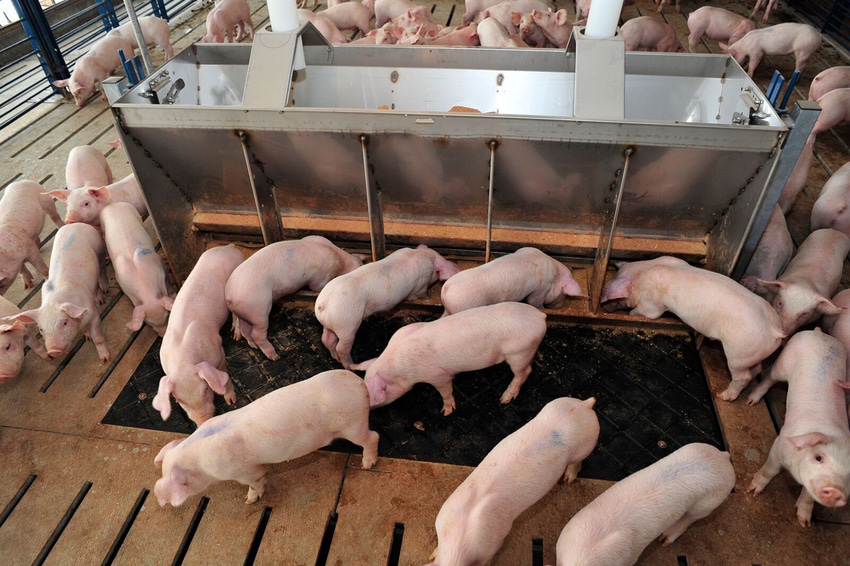Non-nutritive feed additives have the capacity to improve overall feed utilization and sustainability of the pork industry.
September 15, 2022

Feed additives can improve the production performance of grow-finish pigs above what the nutritional components of the diet provide. A feed additive is considered a non-nutritive product that is used to improve growth performance and/or feed efficiency in swine diets. Feed additives have demonstrated impacts in swine production through increasing growth rates, improving feed utilization and efficiency, and/or reducing mortality and morbidity.
Sustainable pig farming and continuous improvement is the commitment of swine producers and feed additives may help achieve this goal. With the right combination of nutrients and feed additives in a swine diet, the animals can grow more efficiently and maximize their genetic potential for lean growth.
Nutrient digestion and absorption are both crucial for efficient use of feed by growing swine. In commercial swine production, feed cost is the single largest expense to the producer, thus making feed utilization the most important part of the overall bottom line.
Improvements in digestion of amino acids in the small intestine of pigs improves efficiency in the conversion of dietary protein into body protein. For a pig to retain a dietary amino acid and incorporate it into body protein, it must be both ingested by the animal and absorbed in the gastrointestinal tract. Measuring amino acid absorption directly can be difficult, so digestibility - the difference between the amount ingested by the animal and the amount that is present after digestion is complete - is measured.
It is known that amino acids that pass through the ileum can be metabolized by the microorganisms in the large intestine and do not largely contribute nutrients to the pig. Therefore, amino acid digestion is measured at the end of the ileum. Non-nutritive feed additives that improve growth performance may do so through effects on amino acid digestibility. Thus, the objective of the study was to investigate two different feed additives, Ambitine and TakTik X-Hit, in the diets of grower pigs on ileal digestibility of amino acids.
At the South Dakota State University Swine Education and Research Facility, a total of 10 pigs, five barrows and five gilts, were surgical implanted with ileal cannulas to collect samples of digesta for determination of the amino acid contents. Each pig was randomly assigned to one of three dietary treatments, in three different collection periods, according to a Latin Square design. Dietary treatments were provided as: 1) Control – standard corn soybean-meal diet; 2) Control plus the addition of Ambitine at 2 lb/ton; 3) Control plus the addition of TakTik X-Hit at 0.2 lb/ton. An indigestible marker of 0.3% titanium was included in each dietary treatment. Each pig was fed the assigned dietary treatment ration at 4% of body weight.
Within each collection period, following an adaption of 5 d to each diet, ileal digesta was then collected for 12 hours each of the two collection days. Small samples of the diets were collected throughout the duration of the trial and then pooled together for further analysis. The digesta samples were stored frozen before freeze drying and grinding. The diet and digesta samples were analyzed for amino acid concentrations analysis at a commercial lab and the values were used to determine amino acid digestibility. Previously determined basal endogenous losses measured by feeding a nitrogen free diet to these same pigs in a previous trial were used to correct the digestibility values.
The digestibility of amino acids, especially the digestibility of Lys, Thr, Trp and Met, and crude protein, were not different according to feed additive inclusions within this trial. These results indicate that the impacts of the non-nutritive feed additives Ambitine and TakTik X-Hit on growing pig performance is not through an impact on amino acid digestibility.
The efficient use of feed is a major concern for swine producers and industry professionals alike. Feed formulation procedures are reliant upon precise nutritional values of ingredients as well as dietary interactions for the growing or reproducing pig. Non-nutritive feed additives have the capacity to improve overall feed utilization and sustainability of the pork industry.
Source: Robert Hoiten, Crystal Levesque and Ryan Samuel, who are solely responsible for the information provided, and wholly own the information. Informa Business Media and all its subsidiaries are not responsible for any of the content contained in this information asset.
You May Also Like



